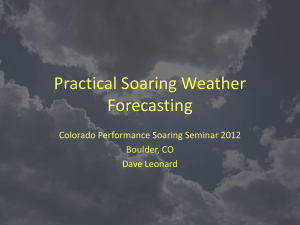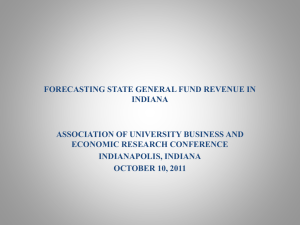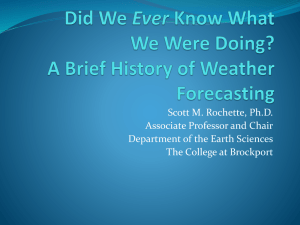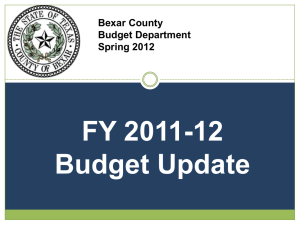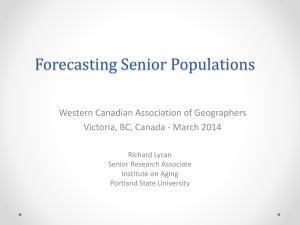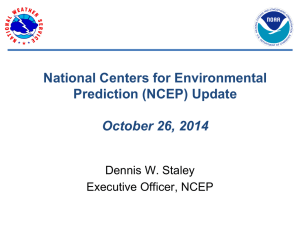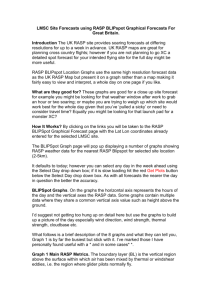Byron WX Seminar
advertisement
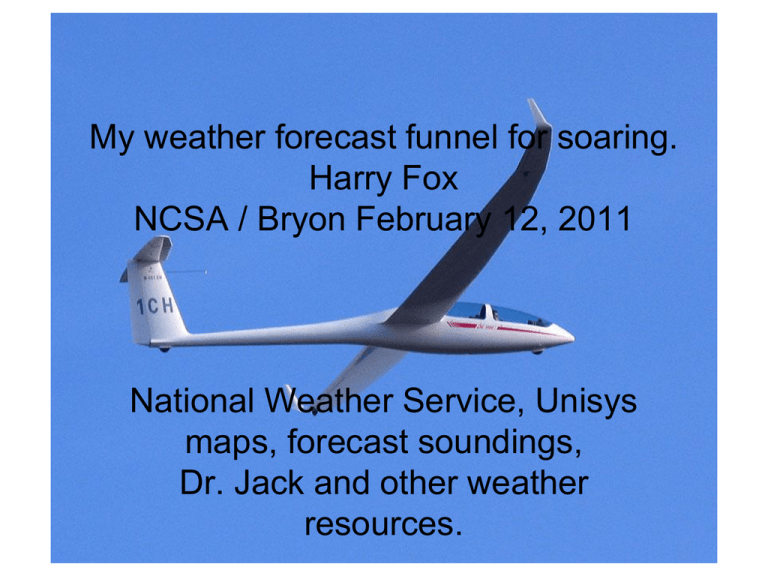
My weather forecast funnel for soaring. Harry Fox NCSA / Bryon February 12, 2011 National Weather Service, Unisys maps, forecast soundings, Dr. Jack and other weather resources. Soaring Conditions in Coastal California • Four types of good soaring days: – Post-frontal thermal conditions. – Hot high-pressure thermal conditions. – Pre-frontal wave. – Post-frontal wave. Post-Frontal Thermal Days • Fall winter and spring, immediately after a cold front sweeps through (often with rain). • Cold air aloft, good lapse rate, usable thermals even with cool temperatures on the ground. • Enough moisture for cumulus clouds to mark lift. • Cloudbase usually too low in winter for cross-country soaring. Hot High-Pressure Days • Spring, summer and fall. • Inversion and seabreeze mean no good lift locally at Byron or Hollister. • Booming thermals 20nm and more from the airport, east of Mount Hamilton and from Panoche south to Avenal. • May be blue thermals or may have cu with high cloudbase. Pre-Frontal Wave • Fall, winter and spring. • Strong south to southwest winds ahead of frontal passage. • Good wave if winds > 20 knots perpendicular to ridgeline, increasing aloft (look for > 65 knots at 300mb). • Moisture and clouds an issue – may be raining when the wave is happening. Post-Frontal Wave • Fall, winter and spring. • Strong north to northeast winds after frontal passage, especially if low pressure center passes to south of us. • Look for >20 knots perpendicular to ridgeline, > 65 knots at 300 mb. • Usually dry air – few or no cloud markers. Example of forecasts for a great soaring day: October 14, 2010. • • • • • On Monday October 11, Matt Gillis and I noted a heating event predicted for later in the week and started looking at forecasts for Wednesday and Thursday conditions. First alert came from basic weather forecasts. By Monday night we concluded that Thursday was likely to have great conditions – worth taking a day off work for. This was based on BLIPMAPs and forecast soundings. Alerts went out on various e-mail groups, and tow pilots were recruited. The result: As many as 30 pilots came out to fly on a weekday from Hollister, Byron, Williams, Crazy Creek, Avenal and Santa Ynez. Flights as long as 620km (OLC distance) were recorded, including the four longest OLC flights in the world that day (from Byron and Hollister). This presentation will focus on October 14 as an example of how to use available forecast tools. Links to weather sources can be found at www.flybasa.org – click on the “Weather” link from the list on left side of BASA home page. National Weather Service (NWS) Forecast Products NWS Monterey Forecast Page NWS point forecast for Hollister NWS Monterey Area Forecast Discussion Each NWS office produces its own zone forecasts and forecast discussions. Useful to consult forecast discussions from different neighboring offices. “AFD” has hyperlinks to definitions. Unisys weather maps Unisys plots weather forecast maps direct from numerical forecast models. Several weather models to choose from, especially for shorter time frames. Parameters include temperature, pressure, winds, relative humidity, Showalter index (a thunderstorm predictor), and surface precipitation. Not all parameters on all maps. Kempton Izuno’s Great Basin forecast parameters. What we want for great soaring in Nevada and the Sierra: • “Four-Corners High” pulls in some moisture from the south. Don’t want high pressure directly over the Great Basin. • Hot (>30 degrees C) at 850 mb (approx. 5000 ft.). • Winds aloft at 300 mb < 20 m/s (approx. 45 mph). • Relative humidity in 30% to 40% range. • Low probability of precipitation. 4-Panel Plot (0Z Oct. 15 forecasts downloaded on Oct. 13) GFS and RUC Soundings • Kurt Thams’s soundings-from-map page. • GFS sounding for Hollister area issued Oct. 13 for 2100Z Oct. 14. Dr. Jack soaring weather products “BLIP” stands for “Boundary Layer Index Prediction”. NAM BLIPMAPs: Based on 12km terrain model. Forecasts up to three days ahead, but +1 and +2 forecasts are usually over-optimistic for thermal heights. Better than RUC at forecasting cloudbase and cloud probability. NAM = “North American Model”, the weather model used. Tends to forecast “phantom lift” in San Joaquin Valley. RUC BLIPMAPs: Available the morning of the forecast day, for multiple times during the day. 13km terrain resolution, but public data files at 20km resolution. RUC = “Rapid Update Cycle”, the weather model used. RUC BLIPSPOTs: Same information as RUC BLIPMAPs, in text format for a single location with many parameters at multiple times. Available the morning of the forecast day. RASP BLIPMAPs: 4km and other resolution, produced for Sierra Nevada, Byron/Hollister, Williams, Avenal and other areas. BLIPMAPs based on numerical weather models • • • • • • • • BL means “Boundary Layer”: the portion of the atmosphere affected by thermals. The BLIPMAPs and BLIPSPOTs result from taking numerical meteorological model outputs produced by the NOAA and reprocessing the numbers to get forecast parameters relevant to soaring pilots. The weather models divide the atmosphere into three-dimensional grids, and compute parameters such as temperature, humidity, wind velocity, cloud cover and precipitation probability for each point on the grid. Each model uses a rough terrain approximation including surface heights and surface type (vegetation, desert, lake, etc.). Horizontal grid spacing is wide (13km/20km for RUC model, 12km for NAM, typically 4km for RASP). Vertical grid spacing is much finer – a few hundred feet at low altitudes. Data from surface observations, balloon soundings, satellite observations and other sources are fed into the models. Different models will reach different conclusions from same input data. BLIPMAP parameters BLTop = Top of thermals. In NAM and RUC, predicts height of usable lift over mountainous areas (NAM and RUC terrain models underestimates height of mountains). In RASP, tends to exaggerate height of usable lift over mountainous areas. Hcrit = Height of usable lift over flat terrain. In RASP, lift over mountains is usually midway between Hcrit and BLTop. Hgt. Variab. = Sensitivity of forecast lift to small change in temperature at surface. A large number means a less reliable forecast. B/S Ratio = Buoyancy versus shearing from wind. B/S of 5 or below means wind-ripped thermals, except perhaps if cu are present. BL Wind = vector-averaged wind speed within boundary layer BLup/down = Forecast convergence or divergence. Note this is averaged over a whole grid square. Cu Potential = Cu likely if number is positive. RUC under-predicts cu in spring and over mountains; NAM tends to give better cu forecasts. Cu Cloudbase for Cu Potential > 0 = Predicted cu locations and cloudbase. OD Potential = Cloud spread-out likely if number is positive. CAPE = Convective Available Potential Energy. A predictor of strong thunderstorms. Vertical Velocity = A wave forecast map. Available only in RASP BLIPMAPs. • • • • • A look at NAM BLIPMAPs, the day before (Wednesday afternoon forecast for Thursday conditions) BLTop Cu cloudbase for Cu potential > 0 BL winds B/S ratio Thermal strength Learning about BLIPMAPs www.drjack.info Descriptions of BLIPMAP parameters. Dr. Jack’s help page. Soaring magazine article. Ramy’s presentation. FAQ page. Forum discussions. RASP BLIPMAPs • Local BLIPMAPs produced from small-scale local weather model (typically 3km or 4km grid). • Produced by volunteers on their own computers, based on code supplied by Dr. Jack. • Same day or up to two days ahead. • Accuracy tends to be good, although too pessimistic about cumulus clouds. Actual thermal heights over mountains tend by be lower than RASP BLTop, but higher than RASP HCrit. • Provide detail for convergence and wave forecasts not available from other BLIPMAPs. BLIPSPOTs • Textual forecast for multiple times on single day at single location. • Based on RUC model. • Available for Air Sailing, Truckee, Williams, Mt. Diablo, Hollister, various other locations. • A BLIPSPOT for Air Sailing. Accessing BLIPMAPs No subscription charge. You must still register to access BLIPMAPs. Use the BLIPMAP Univiewer. It includes access to miniBLIPSPOTs and forecast soundings for any location. XCSkies.com • Commercial website launched a few years ago – subscription $30 per year. • Produces soaring forecast maps similar to Dr. Jack products – but I am skeptical if XCSkies computational models are as sophisticated as Dr. Jack’s. • Slick user interface and map displays. 1km resolution on maps – but the underlying weather models don’t have that much resolution, so don’t take the map detail seriously. • Novel products like route forecasts, 3-day point forecasts. • I tried it for a while but found it did not improve on BLIPMAPs. NWS Aviation Products NWS Monterey Aviation page Reno Soaring Forecast (includes Reno TAF, detailed winds-aloft forecast) Satellite Photos NWS satellite page 1km visible Water vapor Forest Fires and TFRs • National Fire News • FAA graphic TFRs for official TFR plots. • DUATs for official TFR and NOTAM briefings Let Other People Forecast For You • Forecasts posted by other pilots on local newsgroups and bulletin boards: HGCgroup and SoarTruckee groups on Yahoo, VSA’s bulletin board for Williams. • Doug Armstrong forecasts – posted on SoarTruckee Yahoo group. • The “calendar forecast” method – if it’s a weekend, I’m flying. The Results • • • • Great day on October 14. Satellite photo at 2200Z. Ramy’s flight trace. Photos by Matt and Harry. Summary • Start with simple long-range sources: NWS forecasts and forecast discussions. • Long-range sources requiring more interpretation: Unisys weather maps, model forecast soundings. • Medium-range sources (up to 3 days ahead): NAM BLIPMAPs, some RASP sites. • Day-of forecasts: RUC, RASP and NAM BLIPMAPs, RUC BLIPSPOTs. Future of BLIPMAPs and Other Forecasts • Dr. Jack says: BLIPMAPs currently stable and don’t require much attention. Costs are covered from prior subscription revenue. To reduce costs, he plans to transition from dedicated web server to processing BLIPMAPs on his own computer and posting maps on shared web server -- will probably make transition this winter. • Other tools seem stable too – any new sources pilots are using?

